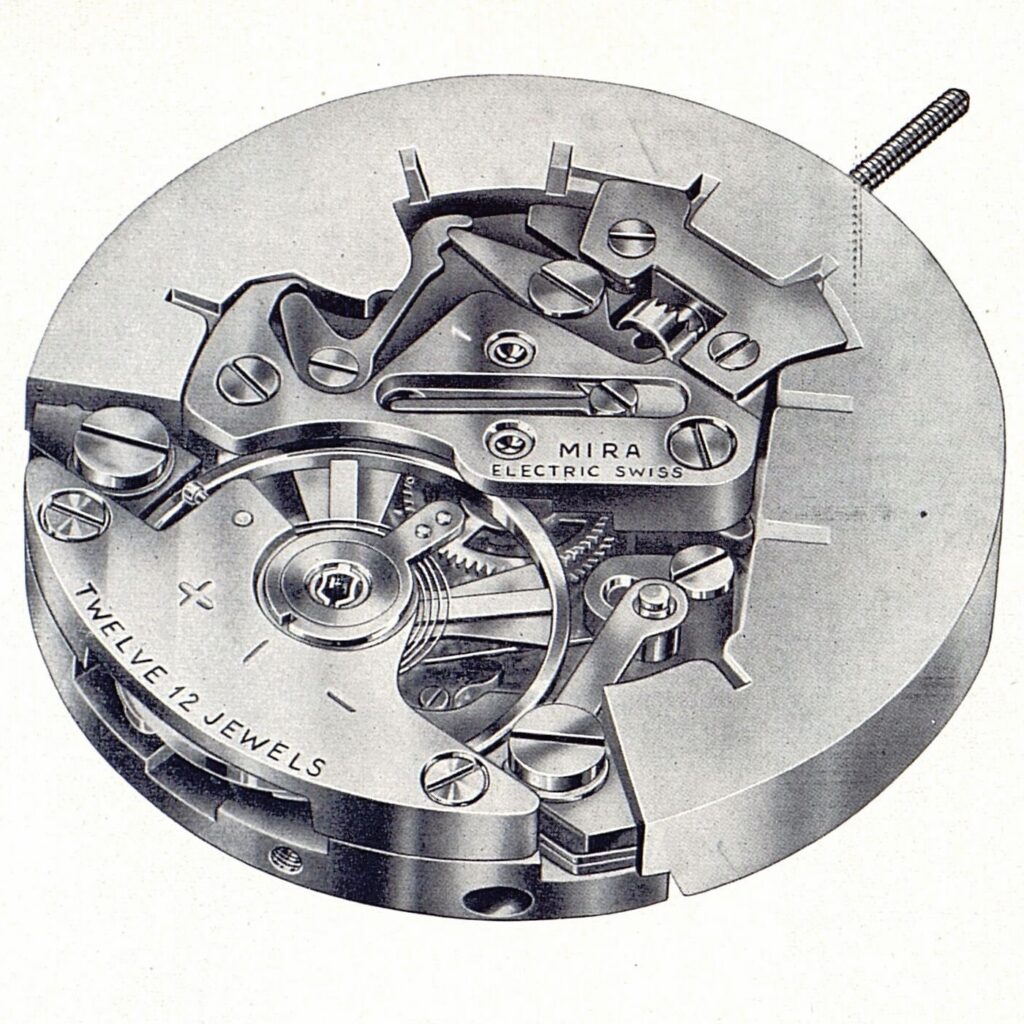
Image: Europa Star Eastern Jeweler 65, 1961
Cal. 4750 was the first Swiss electric watch movement, and was used by over a dozen different brands in the 1960s. The movement was developed by André Beyner and René Besson after a decade of research and development and manufactured at Ebauches SA’s Landeron factory, which was then a branch of FHF. Because the ebauche was made at Landeron, it was stamped with the “L” logo, even though each manufacturer also put their own name on the movement and dial.
Development and Release of Cal. 4750
Patent CH346828 was filed on April 20 and granted on May 31, 1960. The related patent CH345611 was filed on March 27, 1959 and granted on March 31, 1960. Production of Cal. 4750 began at the end of 1960, with the first complete electric watches shown at the Swiss Industries Fair in Basel, which opened on April 15, 1961. These were covered as a breakthrough in contemporary press, since all previous electric watches came from France, Germany, and the United States.
The stated design goals of Beyner and Besson were that the cost be no higher than a similar automatic watch; the timekeeping performance be comparable to a good quality lever watch; the source of energy be separate from the movement; and the watch be as simple as possible to facility assembly and servicing. The final Cal. 4750 was available with either an accumulator or a coin cell WD-4 battery, with the movement in a sealed compartment for reliability.
Some early examples featured odd battery compartments and offset cases, but most were much more conventional. Companies exhibiting electric watches at Basel in 1961 included ARSA, Angelus, Blancpain, Camy, Dulux, Enicar, Invicta, Leonidas, Mira, Reusser, Schild, Sandoz, and Silvana. Some of these featured a lightning bolt motif on the dial as in the ARSA above, but most were quite conventional looking. Unitas ARSA had shown the same watch at Basel in 1960 before production began.
Fixed-Coil Contact-Controlled Electric Movements
Cal. 4750 was a fixed-coil contact-controlled electric movement, meaning it included a balance wheel with an iron segment, a fixed electromagnetic coil, and mechanical contacts to trigger the circuit. The balance spring causes the balance wheel to rotate, with the iron segment pulled by the electromagnetic coil momentarily as a contact closes the electric circuit.
Other similar movements include the LIP R 148 and LIP R 27. The Hamilton 505 was a moving-coil contact-controlled movement, as was the UMF 25, UMF 26, Porta PUW 1001, and Timex M40. All of these feature an electromagnetic coil integrated into the balance which passes over a permanent magnet.
Cal. 4751
In 1962, Ebauches SA introduced Cal. 4751, which was touted as being thinner and having longer run time. The new movement introduced a slimmer battery which reduced the thickness by 1 to 2 mm compared to Cal. 4750. The WD-5 “Mallory” had a capacity of 250 mAh, twice the preceding WD-4, for a guaranteed life of 10 to 12 months. Cal. 4751 also included a hacking lever that stopped the balance when the crown was pulled and was claimed at the time to disconnect the battery from the coil. Electric Watches notes the existence of Cal. 4760, which disconnected the battery, but this feature is specifically noted in coverage of Cal. 4751.
Producers of commercial watches using these movements would include Admiration, Admes, Avia, Baylor, Benrus, Camy, Clinton, Ernest Borel, Eska, Everite, Favre-Leuba, Gruen, Hamilton, Hilton, Huguenin, Onsa, Midland, Mira, Pontiac, Rotary, Royce, Schild, Swisselectric (Derby), Teriam, Tradition, UNIC, Vido, Waltham, West End, and Wittnauer.
Ebauches SA Dynotron
Despite the promise of these movements, they were widely considered a failure. The Swiss press discussed “the commercial failure of their first electric model” when covering the tuning fork and quartz movements from Ebauches SA in 1968. Some of this was due to reliability and charging issues, but the fact that the LIP R 148 was much thinner and more reliable did not help. The Landeron movement was quickly dropped from production.
Ebauches SA turned their attention to developing a smaller and more reliable movement, spending five years to perfect the “Dynotron” Cal. 9150, which was released for sale in 1967. In all, three more generations of ESA electric movements would be produced by the end of the 1970s. The company also developed the “Mosaba” tuning fork line, introduced in 1968, and the revolutionary Beta 21 quartz, introduced in 1970.
